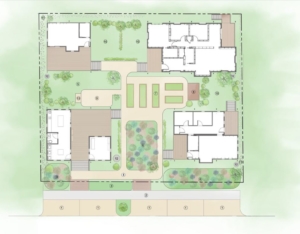It was announced on Earth Day that the Prairie View A&M University School of Architecture Race to Zero team has won the prestigious American Institute of Architects (AIA) Committee on the Environment (COTE) Top Ten for Students Competition for their project, The Fly Flat. The 2018-2019 COTE Top Ten for Students Competition: Innovation 2030 recognized ten design proposals that best combined design excellence and environmental performance. The student team for the AIA Cote Top Ten submission included Kennia Lopez, Cynthia Suarez-Harris, and Ledell Thomas, working with Faculty Lead and Assistant Professor Shelly Pottorf. Additional team members for previous project development included students Kristen Clark, Aaron Farray, Shannen Martin, Noah Perkins, Shelby Skinner, Kaylah Wesley, Reuben Cheeks as well as Shannon Bryant, Woodshop Supervisor and Design-Build Specialist, and April Ward, Assistant Professor.
The Fly Flat is a net zero infill housing vision that aims to achieve economic, social, and environmental resilience in Houston’s low-income, minority neighborhoods. This project previously garnered international, state and local recognition winning the Grand Award in the U.S. Department of Energy’s Race to Zero Competition, a Texas Society of Architects Studio Design Award, and an AIA Houston/City of Houston Complete the Community Housing Award. In addition, the project has been presented by the student team and faculty lead Shelly Pottorf as the closing keynote at the North American Passive House Conference, the ASHRAE Annual Conference, the International Forum on Urbanism, and the Living Future unConference.
INTRODUCTION
Architects play a crucial role in addressing both the causes and effects of climate change through the design of the built environment. Innovative design thinking is key to producing architecture that meets human needs for both function and delight, adapts to climate change projections, continues to support the health and well-being of inhabitants despite natural and human-caused disasters, and minimizes contributions to further climate change through greenhouse gas emissions. Preparing today’s architecture students to envision and create a climate adaptive, resilient, and carbon-neutral future must be an essential component and driving force for design discourse.
Given their long lifespan, new buildings must be designed to address solutions to climate change and to respond to its projected impacts, well into the second half of the 21st Century and beyond. As with the COTE Top Ten award for built work by design professionals, COTE Top Ten for Students allows designs to be characterized in terms of 10 measures ranging from Community to Water to Wellness.
ABOUT THE COMPETITION
The American Institute of Architects Committee on the Environment (AIA COTE), in partnership with the Association of Collegiate Schools of Architecture (ACSA), is pleased to announce the winners of the fifth annual AIA COTE Top Ten for Student Competition: INNOVATION 2030. The program challenges students, working individually or in teams, to submit projects that use a thoroughly integrated approach to architecture, natural systems, and technology to provide architectural solutions that protect and enhance the environment. The competition recognizes ten exceptional studio projects that seamlessly integrate adaptive, resilient, and strategies for moving towards carbon-neutral operation within their broader design concepts. The competition is open to students from ACSA Member Schools from the U.S., Canada and Mexico. The competition is open to upper level students (third year or above, including graduate students).
